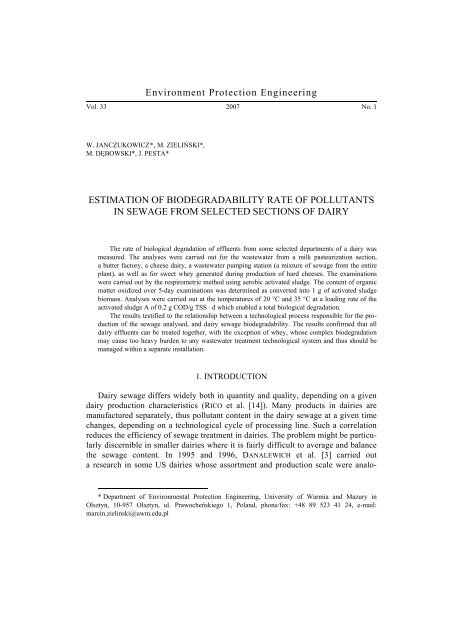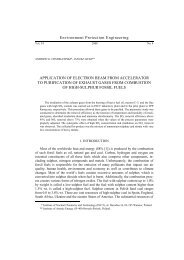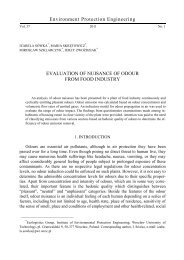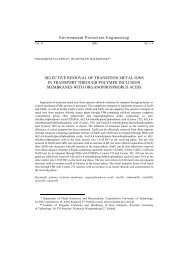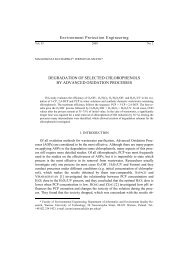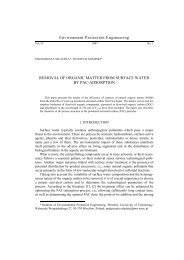Inne spojrzenie na proces mieszania - EPE Environment Protection ...
Inne spojrzenie na proces mieszania - EPE Environment Protection ...
Inne spojrzenie na proces mieszania - EPE Environment Protection ...
Create successful ePaper yourself
Turn your PDF publications into a flip-book with our unique Google optimized e-Paper software.
<strong>Environment</strong> <strong>Protection</strong> Engineering<br />
Vol. 33 2007 No. 1<br />
W. JANCZUKOWICZ*, M. ZIELIŃSKI*,<br />
M. DĘBOWSKI*, J. PESTA*<br />
ESTIMATION OF BIODEGRADABILITY RATE OF POLLUTANTS<br />
IN SEWAGE FROM SELECTED SECTIONS OF DAIRY<br />
The rate of biological degradation of effluents from some selected departments of a dairy was<br />
measured. The a<strong>na</strong>lyses were carried out for the wastewater from a milk pasteurization section,<br />
a butter factory, a cheese dairy, a wastewater pumping station (a mixture of sewage from the entire<br />
plant), as well as for sweet whey generated during production of hard cheeses. The exami<strong>na</strong>tions<br />
were carried out by the respirometric method using aerobic activated sludge. The content of organic<br />
matter oxidized over 5-day exami<strong>na</strong>tions was determined as converted into 1 g of activated sludge<br />
biomass. A<strong>na</strong>lyses were carried out at the temperatures of 20 °C and 35 °C at a loading rate of the<br />
activated sludge A of 0.2 g COD/g TSS · d which e<strong>na</strong>bled a total biological degradation.<br />
The results testified to the relationship between a technological <strong>proces</strong>s responsible for the production<br />
of the sewage a<strong>na</strong>lysed, and dairy sewage biodegradability. The results confirmed that all<br />
dairy effluents can be treated together, with the exception of whey, whose complex biodegradation<br />
may cause too heavy burden to any wastewater treatment technological system and thus should be<br />
ma<strong>na</strong>ged within a separate installation.<br />
1. INTRODUCTION<br />
Dairy sewage differs widely both in quantity and quality, depending on a given<br />
dairy production characteristics (RICO et al. [14]). Many products in dairies are<br />
manufactured separately, thus pollutant content in the dairy sewage at a given time<br />
changes, depending on a technological cycle of <strong>proces</strong>sing line. Such a correlation<br />
reduces the efficiency of sewage treatment in dairies. The problem might be particularly<br />
discernible in smaller dairies where it is fairly difficult to average and balance<br />
the sewage content. In 1995 and 1996, DANALEWICH et al. [3] carried out<br />
a research in some US dairies whose assortment and production scale were a<strong>na</strong>lo-<br />
* Department of <strong>Environment</strong>al <strong>Protection</strong> Engineering, University of Warmia and Mazury in<br />
Olsztyn, 10-957 Olsztyn, ul. Prawocheńskiego 1, Poland, phone/fax: +48 89 523 41 24, e-mail:<br />
marcin.zielinski@uwm.edu.pl
78<br />
W. JANCZUKOWICZ et al.<br />
gous. The researchers revealed that the effluent flow differed within a range of 170<br />
and 2081 m 3 /d. In most factories, the sewage flow volumetric intensity was observed<br />
to vary on a seaso<strong>na</strong>l, diur<strong>na</strong>l and hourly bases, with the minimum effluent<br />
flow ranging from 4 to 170 m 3 /d and the maximum from 257 to 2650 m 3 /d. Diur<strong>na</strong>l<br />
and hourly fluctuations in the amount of sewage produced were connected with<br />
washing the appliances and rooms at the end of each <strong>proces</strong>sing cycle. Whereas<br />
seaso<strong>na</strong>l lability was attributed to milk <strong>proces</strong>sing rates being higher in summer and<br />
lower in winter.<br />
The organic compounds loading rate in dairy sewage is determined by the amount<br />
of lactose, fats and proteins (ŐZTURKET et al. [11], PERLE et al. [12]). The relationship<br />
between these substances can be extremely varied, which affects their susceptibility to<br />
biological treatment. Sewage reaction and temperature are other factors which determine<br />
biodegradation efficiency (ERGURDER et al. [4]).<br />
Under a<strong>na</strong>erobic conditions ammonia and amino acids are the primary products<br />
of protein biodegradation. Some milk proteins, for instance casein, are resistant<br />
to biodegradation, therefore in order to be biodegraded they require microorganisms<br />
that are appropriately adapted. Some experiments show that biogas production from<br />
casein in the case of u<strong>na</strong>dapted sludge (3.7 g COD/dm 3 d) achieves low values<br />
(0.25 cm 3 CH4/h) with a lag phase of 50 h, whereas at the adapted sludge –<br />
0.79 CH4/h. Casein does not inhibit a<strong>na</strong>erobic changes within the concentration<br />
range of 0–3 g/dm 3 (PERLE et al. [12]).<br />
In comparison to proteins, hydrocarbons are more susceptible to biodegradation<br />
which occurs easier and faster. Lactose, which is found in dairy sewage, is biodegraded<br />
to propionic acid, ethanol and acetate. Yet, the presence of some intermediate<br />
products of biodegradation, undissociated forms in particular, may hinder<br />
a<strong>na</strong>erobic changes (AGUILAR et al. [1]).<br />
Biodegradation of fats may be rendered difficult as their biodegradability rate is<br />
very low (PETRUY and LETTINGA [13]). In dairy sewage, fats generate glycerol and<br />
long-chain fatty acids. Glycerol does not cause inhibition, whereas long-chain fatty<br />
acids, both saturated (12–14 carbon atoms) and unsaturated (18 carbon atoms)<br />
(PERLE et al. [12]), may be harmful to various microorganisms, to methanogenous<br />
bacteria in particular. Such a harmful effect is attributed to double bonds and cis<br />
isomers, which occur in <strong>na</strong>tural fats.<br />
The rate of biochemical decomposition of waste depends on the activity of microorganisms<br />
(precisely – on the enzymatic reaction rate). The activity of enzymes,<br />
and consequently the biochemical reaction rate, depends on the ambient conditions,<br />
i.e., the substrate concentrations, temperature, redox potential, osmotic pressure and<br />
on the presence of enzyme-activating and inhibiting substances.<br />
The relationship between a reaction rate and temperature is expressed by the<br />
Van’t Hoff–Arrhenius’ equation. A transformed form of the equation is commonly<br />
used, which compares the reaction rates at different temperatures:
where:<br />
Estimation of biodegradability rate of dairy sewage 79<br />
⎞<br />
⎤<br />
⎢ ⎜<br />
⎟<br />
⎟(<br />
T1<br />
−T2<br />
) ⎥<br />
⎢⎣<br />
⎝ 1T2<br />
⎠ ⎥⎦ k = k e<br />
, (1)<br />
T<br />
1<br />
T<br />
2<br />
⎡⎛<br />
E<br />
RT<br />
kT1 – the reaction rate constant at the temperature T1 in variable units, depending<br />
on the reaction order,<br />
kT2 – the reaction rate constant at the temperature T2 in variable units, depending<br />
on the reaction order,<br />
E – activation energy [J/mol],<br />
R – universal gas constant [8.314 J/mol . K],<br />
T1,2 – the temperature [K].<br />
A transformed form of the equation is more commonly applied in modelling the<br />
<strong>proces</strong>ses of waste treatment:<br />
k<br />
T1<br />
= k θ<br />
20<br />
( T1<br />
−T20<br />
)<br />
, (2)<br />
where θ is the temperature coefficient.<br />
The effect of temperature on the enzyme-catalysed reaction rate is produced by<br />
two <strong>proces</strong>ses. An increase in temperature is accompanied by an enzyme-catalysed<br />
reaction, which is consistent with the Van’t Hoff–Arrhenius’ equation. However,<br />
because of the protein character of enzymes the relationship is only valid below<br />
a certain temperature value. An increase in temperature above the optimum value<br />
for a given enzyme brings about its de<strong>na</strong>turation.<br />
Most bacteria which take part in waste treatment <strong>proces</strong>ses are mesophilic organisms<br />
(HENZE et al. [5]). It is assumed that the <strong>proces</strong>s rate in aerobic, heterotrophic<br />
decomposition of organic compounds increases exponentially according to equation<br />
(2) when temperature changes from 0 °C to 32 °C. Between 32 °C and 40 °C, the<br />
<strong>proces</strong>s rate is constant and afterwards it plummets to reach zero at 45 °C. The<br />
<strong>proces</strong>s of aerobic decomposition of organic compounds can run in thermophilic<br />
conditions between 50 °C and 60 °C. Under these conditions, the <strong>proces</strong>s rate will<br />
be by 50% higher than at 35 °C. The nitrification <strong>proces</strong>s rate increases with temperature<br />
until about 30–35 °C. When the temperature reaches 40 °C, the <strong>proces</strong>s rate<br />
drops to zero. No activity of nitrifying bacteria was found in thermophilic intervals<br />
of 50–60 °C. The relationship between the nitrification <strong>proces</strong>s and the temperature<br />
is similar to that observed during the aerobic decomposition of organic compounds.<br />
The <strong>proces</strong>s rate rises exponentially up to about 32–35 °C. It is assumed that the<br />
nitrification <strong>proces</strong>s can run at temperatures which are typical of thermophilic bacteria.
80<br />
W. JANCZUKOWICZ et al.<br />
2. METHODOLOGY<br />
2.1. THE SEWAGE CHARACTERISTICS<br />
The research on the biodegradability of some dairy sewage was based on respirometric<br />
methods. In the experiment, the researchers used activated sludge adapted to<br />
dairy sewage biodegradation under aerobic conditions.<br />
The sewage origin<br />
Physical and chemical characteristics of the dairy sewage being a<strong>na</strong>lysed<br />
BOD5<br />
mg /dm 3<br />
COD<br />
mg /dm 3<br />
BOD 5/COD<br />
mg /dm 3<br />
Total suspended<br />
solids<br />
mg /dm 3<br />
Fats<br />
mg /dm 3<br />
Table 1<br />
Apparatus room 3470 14639 0.27 3821 3105 10.37<br />
Butter section 2423 8925 0.27 5066 2882 12.08<br />
Pumping station 797 2542 0.31 653 1056 7.18<br />
Cheese section 3456 11753 0.29 939 330 7.90<br />
Cottage cheese section 2599 17645 0.15 3375 950 7.83<br />
Hard cheese whey 29480 73445 0.4 7152 994 5.80<br />
The sewage selected for the experiment displayed diverse values of physical and<br />
chemical properties (table 1). It was collected from the following sections of the dairy<br />
<strong>proces</strong>sing line:<br />
• The apparatus room – the sewage origi<strong>na</strong>ted from washing the equipment such as<br />
centrifuges, devices and installations used for milk thermal <strong>proces</strong>sing, homogenisation,<br />
condensation and out-gassing (de-aeration). The sewage varied in content, depending<br />
on the detergents used for washing.<br />
• The butter section – the sewage origi<strong>na</strong>ted from washing the rooms, devices<br />
and installations used in butter production. Its characteristic feature was high content<br />
of fats.<br />
• The milk reception point – the sewage origi<strong>na</strong>ted from washing the cisterns,<br />
pipes, floors and drives. Its texture resembled highly-diluted milk.<br />
• The cheese and cottage cheese section – the sewage origi<strong>na</strong>ted from washing the<br />
devices and installations for hard cheese and cottage cheese production, respectively.<br />
It was marked by high rates of organic pollutants.<br />
Apart from these the following liquids were a<strong>na</strong>lysed in the research:<br />
• Hard cheese whey – a secondary product of hard cheese production (sweet whey).<br />
• Cottage cheese whey – a secondary product of white cottage cheese production<br />
(sour whey).<br />
• Mixed sewage – all the sewage combined in one stream (the pumping station sewage).<br />
pH
Estimation of biodegradability rate of dairy sewage 81<br />
2.2. THE MEASUREMENT EQUIPMENT<br />
The dairy sewage biodegradability rate under aerobic conditions was measured by<br />
means of respirometric Oxi-Top apparatus by WTW company. The measurement<br />
equipment consisted of a reaction tank and a recorder.<br />
The reaction tank held an appropriate amount of the sewage a<strong>na</strong>lysed and a portion<br />
of activated sludge standardised for all measurements. The reaction tank was<br />
firmly attached to the recorder, which traced and registered the changes of partial<br />
pressure inside the reaction tank. For cellular respiration the microorganisms in the<br />
activated sludge used organic compounds from the sewage a<strong>na</strong>lysed. The measurements<br />
were carried out under aerobic conditions. The microorganisms used the oxygen<br />
from the reaction tank as the electrons’ acceptor and in turn released carbon<br />
dioxide being an ultimate product of carbon compound changes under aerobic conditions.<br />
In the reaction tank, carbon dioxide was bound by the absorbent, sodium<br />
alkali (NaOH), which led to the change in the partial pressure inside the reaction<br />
tank. The pressure was automatically measured and registered by the recorder,<br />
which simultaneously converted the values of the registered partial pressure into the<br />
amount of oxygen used by the microorganisms.<br />
Consistently, a single reaction tank was supplied with the same amount of the<br />
activated sludge biomass. Following that an appropriate amount of the dairy sewage<br />
was supplied, prior to which the content of organic compounds (COD) in the<br />
sewage had been defined. The experiment was conducted on the activated sludge at<br />
the applied pollutant loading COD of A′ = 0.2 g COD/g TSS · d; the tests were<br />
carried out at the temperature of 20 °C and 35 °C. The measurement session lasted<br />
5 days, during which 1.0 g of organic matter (COD) from the treated sewage per<br />
1.0 g of the activated sludge dry mass was supplied at a time to the reaction tank.<br />
The activated sludge used in the research was obtained from the ancillary reactor<br />
operating in a time cycle (SBR). The sludge load in that reactor was maintained at<br />
the level of A′ = 0.2 g COD/g TSS · d. The activated sludge used in the experiment<br />
was adapted to dairy sewage biodegradation. The culture medium used in the ancillary<br />
reactor comprised synthetic sewage which had been formed on the basis of<br />
powdered milk.<br />
2.3. STATISTIC METHODS<br />
In each temperature variant, the measurements were made in five replications irrespective<br />
of the type of the wastewater examined. The results obtained were<br />
<strong>proces</strong>sed to determine the mean value, standard deviation and standard error of the<br />
mean. If the value of standard error was below 10%, it was assumed that the results<br />
were characterized by a low variability, and the mean value calculated was reliable.<br />
Thus, the mean values obtained were used to determine the fi<strong>na</strong>l results that were
82<br />
W. JANCZUKOWICZ et al.<br />
calculated as a mean value of results recorded for particular sample collections.<br />
They, in turn, were used to estimate the constants of the reaction rate. The constants<br />
were determined based on experimental data using the non-linear regression method.<br />
A conformity index φ 2 was accepted as a measure of curve matching to experimental<br />
data, which e<strong>na</strong>bled the reaction order and reaction rate constant k to be<br />
determined.<br />
3. RESULTS<br />
The susceptibility of dairy wastewaters was subject to changes, depending on the<br />
production <strong>proces</strong>s they origi<strong>na</strong>ted from. The <strong>proces</strong>sing methods of raw material<br />
determine the quality and composition of wastewaters produced, which in turn affects<br />
decomposition rate of effluents occurring in sewage. In all the types of sewage under<br />
exami<strong>na</strong>tion, the decomposition <strong>proces</strong>s of organic compounds proceeded according<br />
to the zero-order reaction, irrespective of the fact whether the measurements were<br />
carried out at a temperature of 20 °C or 35 °C.<br />
The highest rate of oxidation was observed in the case of wastewaters origi<strong>na</strong>ted<br />
from the cheese dairy. At a temperature of 20 °C, the decomposition rate r reached<br />
0.0039 mg O2/mg TSS · h. The elevation of the <strong>proces</strong>s temperature to 35 °C increased<br />
the reaction rate up to 0.0071 mg O2/mg TSS · h (figure). At a temperature<br />
of 20 °C, the decomposition rates of sewage from the pumping station and butter<br />
factory were similar and accounted for r = 0.0020 mg O2/mg TSS · h. Also, in the<br />
case of wastewater from the butter factory, the oxidation of organic compounds was<br />
observed to proceed at a negligibly lower rate, i.e., r = 0.0017 mg O2/mg TSS · h. A<br />
rise in the <strong>proces</strong>s temperature to 35 °C resulted in a twofold increase in the decomposition<br />
rate of wastewaters from the butter factory and the milk pasteurization section.<br />
At a higher temperature, sewage from the pumping station, being a mixture of<br />
effluents from all production lines, was observed to decompose at over threefold<br />
higher rate, i.e., r = 0.0061 mg O2/mg TSS · h (figure). Of all the six departments of<br />
dairy production examined, the least decomposable appeared to be the wastewaters<br />
from fresh white cheese dairy and whey origi<strong>na</strong>ting from the production of hard<br />
cheeses. The decomposition rate of sewage from fresh white cheese dairy accounted<br />
for r = 0.0012 mg O2/mg TSS · h at a temperature of 20 °C and for r = 0.0028 mg<br />
O2/mg TSS · h at a temperature of 35 °C. The oxidation of whey appeared to proceed<br />
at the lowest rate at both temperature intervals. Moreover, in the case of those<br />
effluents, a rise in temperature accelerated the oxidation <strong>proces</strong>s only to a slight<br />
extent. At a temperature of 20 °C, the decomposition rate r reached 0.0010 mg<br />
O2/mg TSS · h, whereas at 35 °C the oxidation rate was as low as 0.0013 mg O2/mg<br />
TSS · h (figure).
[mgO 2 /mg TSS]<br />
[mgO 2 /mg TSS]<br />
[mgO 2 /mg TSS]<br />
1,0<br />
0,8<br />
0,6<br />
0,4<br />
0,2<br />
0,0<br />
1,0<br />
0,8<br />
0,6<br />
0,4<br />
0,2<br />
0,0<br />
1,0<br />
0,8<br />
0,6<br />
0,4<br />
0,2<br />
0,0<br />
20oC 35oC<br />
Estimation of biodegradability rate of dairy sewage 83<br />
The apparatus room<br />
y = 0,0038x<br />
y = 0,0017x<br />
0 20 40 60 80 100 120<br />
time [h]<br />
20oC 35oC<br />
20oC 35oC<br />
The cheese section<br />
The mixed sewage<br />
y = 0,0071x<br />
y = 0,0039x<br />
0 20 40 60 80 100 120<br />
time [h]<br />
y = 0,0061x<br />
y = 0,002x<br />
0 20 40 60 80 100 120<br />
time [h]<br />
[mgO 2 /mg TSS]<br />
[mgO 2 /mg TSS]<br />
[mgO 2 /mg TSS]<br />
1,0<br />
0,8<br />
0,6<br />
0,4<br />
0,2<br />
0,0<br />
1,0<br />
0,8<br />
0,6<br />
0,4<br />
0,2<br />
0,0<br />
1,0<br />
0,8<br />
0,6<br />
0,4<br />
0,2<br />
0,0<br />
20oC 35oC<br />
The butter section<br />
y = 0,0049x<br />
y = 0,0019x<br />
0 20 40 60 80 100 120<br />
time [h]<br />
20oC 35oC<br />
20oC 35oC<br />
The cottage cheese section<br />
The hard cheese whey<br />
y = 0,0028x<br />
y = 0,0012x<br />
0 20 40 60 80 100 120<br />
time [h]<br />
y = 0,0013x<br />
y = 0,001x<br />
0 20 40 60 80 100 120<br />
time [h]<br />
Decomposition rate of wastewaters from selected dairy production departments<br />
The determined values of a temperature coefficient θ indicate a correlation between<br />
the oxidation rate of effluents and the temperature of the <strong>proces</strong>s. Of the wastewaters<br />
examined, an increase in temperature affected to the greatest extent the decomposition<br />
of effluents contained in the sewage from the pumping station. The value of<br />
the temperature coefficient accounted for θ = 1.077 (table 2). Also, in the case of sewage<br />
from the butter factory, the rate of the oxidation <strong>proces</strong>s was observed to increase<br />
considerably with a temperature rise to 35 °C. The temperature coefficient θ<br />
reaching 1.065 testified to an over two times higher amount of oxidized organic matter
84<br />
W. JANCZUKOWICZ et al.<br />
when converted into dry matter of the activated sludge used in the study (table 2). The<br />
elevated temperature was observed to have the least significant effect on the decomposition<br />
rate of whey, for which the temperature coefficient θ was the lowest and reached<br />
1.012. A rise in temperature practically did not increase the amount of the oxidized<br />
organic matter.<br />
Values of temperature coefficient θ<br />
Table 2<br />
Waste source Temperature coefficient θ<br />
Apparatus room 1.056<br />
Butter section 1.065<br />
Cheese section 1.041<br />
Cottage cheese section 1.042<br />
Mixed sewage 1.077<br />
Hard cheese whey 1.012<br />
4. DISCUSSION<br />
Major components of dairy effluent are as follows: a high load of organic compounds,<br />
some lipids, suspension and biogenic elements. In the case of dairy sewage, the<br />
proportions of lipids, proteins and carbohydrates may be very differentiated, which is of<br />
significant importance to the possibilities of their treatment (ERGURDER et al. [4]).<br />
In general, carbohydrates are more readily and rapidly decomposed compared to<br />
proteins. Lactose present in dairy sewage decomposes to propionic acid, ethanol and<br />
acetate. Nevertheless, the presence of intermediate forms of decomposition, especially<br />
of the non-dissociated ones, is likely to inhibit biological transformations (AGUILAR<br />
[1]). The biodegradation of lipids is hindered due to their low biosusceptibility to decomposition<br />
(PETRUY and LETTINGA [13]). Lipids in the dairy sludge are degraded to<br />
glycerol and long-chain fatty acids. Glycerol has been reported not to exert an inhibiting<br />
effect (PERLE et al. [12]), whereas the long-chain saturated (12–14 C) and unsaturated<br />
(18 C) fatty acids have been reported to be detrimental to various microorganisms,<br />
especially to methanogenic bacteria. Their harmful effect is linked with double<br />
bonds and cis isomers present in <strong>na</strong>tural lipids.<br />
The presence of lipids caused that sewage from the butter factory was decomposed<br />
at a slower rate than the wastewaters from cheese dairy oxidized at the highest rate.<br />
A rise in the <strong>proces</strong>s temperature to 35 °C resulted in a remarkably increased decomposition<br />
rate of sewage from the butter factory. This was linked with easier emulsification<br />
of lipids at a higher temperature, thus with their increased susceptibility to hydrolyzing<br />
enzymes. The high decomposition rate of sewage from the cheesemaking<br />
<strong>proces</strong>s testifies to a high content of carbohydrates. Contrary to expectations, the de-
Estimation of biodegradability rate of dairy sewage 85<br />
composition <strong>proces</strong>s of wastewaters from the milk pasteurization section did not indicate<br />
any negative influence on chemical agents used for rinsing and washing the system.<br />
The washing <strong>proces</strong>s of a dairy system involves a number of detergents and disinfecting<br />
agents (DANALEWICH et al. [3]). These substances reveal, most of all,<br />
antiseptic and bactericidal activities as well as a contribution to an increased load of<br />
organic effluents in sewage by reducing the BOD5 /COD ratio and to increased concentration<br />
of biogenic elements. As demonstrated in the study, the decomposition rate<br />
of sewage from the milk pasteurization section was comparable and even higher than<br />
that of effluents origi<strong>na</strong>ting from the other sources. In aerobic decomposition of sewage<br />
from the milk pasteurization section, no lag phase occurred. The oxidation of<br />
effluents was observed immediately after the measurement had commenced. A high<br />
decomposition rate of effluents in the sewage origi<strong>na</strong>ting from the pumping station is<br />
highly interesting. This sewage was a mixture of effluents from all the sources a<strong>na</strong>lyzed.<br />
Its high decomposition rate r of 0.0061 mg O2/mg TSS · h was most likely due<br />
to the fact that it was subject to putrefaction in a storage reservoir, which resulted in<br />
the production of readily available volatile acids. In contrast, wastewaters from the<br />
other sources were subjected to a<strong>na</strong>lyses immediately when produced.<br />
Of all effluents examined, definitely the lowest oxidation rate was observed for those<br />
of whey origi<strong>na</strong>ting from the production of hard cheeses. Cheese whey, a product of the<br />
cheesemaking industry, is rich in proteins and lactose. As much as 99 % of whey is biodegradable<br />
and its high content of organic matter being referred to as chemical oxygen<br />
demand (COD) − reaching 70 g COD/dm 3 on average. Yet, compared to this high load, it<br />
demonstrates low alkalinity, i.e., 2500 mg CaCO3/dm 3 (MAWSON [9]). For this reason,<br />
the oxidation of whey may be rendered difficult. MALASPINA et al. [8] reported that<br />
whey may be troublesome during a<strong>na</strong>erobic treatment due to its low alkalinity, which<br />
leads to rapid souring. Moreover, whey poses problems with the production of pelleted<br />
sludge as well as tends to produce excessive amounts of viscous exopolymers, most<br />
probably of bacterial origin inhibiting the floccules’ capacity for sedimentation which, in<br />
turn, may cause their washing out (VIDAL et al. [15]). Problems with the utilization of<br />
whey were confirmed in the study reported. Even at a temperature of 35 °C the decomposition<br />
rate of whey was over twice as low as that of second-in-row effluents from fresh<br />
white cheese dairy and over five times lower than that of effluents from the cheese dairy<br />
decomposed at the highest rate.<br />
Investigations into the decomposition of effluents origi<strong>na</strong>ting in different stages of<br />
dairy production were carried out at two temperatures: 20 °C and 35 °C. According to<br />
the Van’t Hoff–Arrhenius equation, the reaction rate increased along with a rise in the<br />
<strong>proces</strong>s temperature. In this equation, the reaction rate at a specified temperature is<br />
referred to the reaction rate at a standard temperature of 20 °C. The temperature coefficient<br />
θ, present in the equation, e<strong>na</strong>bles determining to what extent the changes in<br />
temperature affect the reaction rate. However, it is emphasized that the equation is true<br />
for the systems in which the rate is not limited by a substrate concentration
86<br />
W. JANCZUKOWICZ et al.<br />
(LEWANDOWSKI [7]). The values of the temperature coefficient θ allowed the correlation<br />
between the culture medium (type of sewage) applied and the effect of temperature<br />
on the activity of the sludge to be a<strong>na</strong>lyzed. An increase in the <strong>proces</strong>s temperature<br />
was found to have the weakest impact on the decomposition rate of effluents from<br />
whey, and the most profound effect on the decomposition of sewage origi<strong>na</strong>ting from<br />
the intermediate pumping station. HENZE et al. [5] suggest that a low value of the temperature<br />
coefficient (θ = 1.07) is typical of heterotrophic <strong>proces</strong>ses. KADLEC and<br />
REDDY [6] claim that temperature has a negligible impact on BOD5 removal. During<br />
the aerobic decomposition of organic matter, the value of the temperature coefficient θ<br />
reached 1.08 for activated sludge and 1.035 for biological filters. The coefficient values<br />
reported by these authors confirmed the lower susceptibility of biological filters to<br />
unfavourable changes in temperature determined by other authors (ANDERSSON [2])<br />
compared to that of the activated sludge. The studies by MAYO and NOIKE [10] into<br />
heterotrophic bacteria cells’ capability to form colonies have demonstrated no differences<br />
in the <strong>proces</strong>s rate at temperatures of 20 °C and 35 °C. In addition, these authors<br />
have emphasized that, under stable conditions, the heterotrophic bacteria were not<br />
susceptible to temperature changes within the range of 10–20 °C. The numbers of<br />
these bacteria at temperatures of 10 and 20 °C were similar. WU et al. [16] demonstrated<br />
that at temperature over 15 °C an increase in the removal efficiency of organic<br />
compounds was directly proportio<strong>na</strong>l to the increasing temperature, and that above 25<br />
°C the efficiency declined. KADLEC and REDDY [6] claimed that the reaction of microorganisms<br />
was determined by temperature to a greater extent at its lower range, i.e.,<br />
Estimation of biodegradability rate of dairy sewage 87<br />
5. CONCLUSIONS<br />
1. The decomposition rate of dairy sewage was linked with its origin, which had<br />
a direct impact on the content and quality of proteins, lipids and carbohydrates occurring<br />
in wastewaters.<br />
2. A rise in the <strong>proces</strong>s temperature from 20 °C to 35 °C caused a considerable increase<br />
in the decomposition rate of effluents origi<strong>na</strong>ted from the sewage examined.<br />
The only exception were the effluents contained in whey.<br />
3. A higher decomposition rate of the effluents at a temperature of 35 °C was more<br />
likely to result from the presence of more readily decomposable forms of effluents<br />
(e.g., upon lipid emulsification) than from the increased activity of bacteria.<br />
4. No inhibitory effect of chemical agents was observed on the decomposition of<br />
sewage origi<strong>na</strong>ted from the milk pasteurization section.<br />
5. The high decomposition rate of effluents from the pumping station resulted from<br />
their initial a<strong>na</strong>erobic decomposition in the fermentation <strong>proces</strong>s proceeding in the<br />
storage reservoir. Thus, the increased concentration of volatile fatty acids contributed<br />
to a more rapid decomposition of the effluents under aerobic conditions.<br />
ACKNOWLEDGEMENTS<br />
The study was fi<strong>na</strong>nced from the resources of the State Committee for Scientific Research in 2003–<br />
2005 under project No. 4 TO 9D 032 25.<br />
REFERENCES<br />
[1] AGUILAR A., CASAS C., LEMA J.M., Degradation of volatile fatty acids by differently enriched methanogenic<br />
cultures: kinetics and inhibition, Water Research, 1995, 29 (2), 505–509.<br />
[2] ANDERSSON B., Tentative nitrogen removal with fixed bed <strong>proces</strong>ses in Malmö sewage treatment<br />
plant, Wat. Sci. Tech., 1990, 22, 1/2, 239–250.<br />
[3] DANALEWICH J.R., PAPAGIANNIS T.G., BELYEA R.L., TUMBLESON M.E., RASKIN L., Characterization of<br />
dairy waste streams, current treatment practices and potential for biological nutrient removal, Wat.<br />
Res., 1998, 32 (12), 3555–3568.<br />
[4] ERGURDER T.H., TEZELE U., GUVEN E., DEMIRER G.N., A<strong>na</strong>erobic biotransformation and methane<br />
generation potential of cheese whey in batch and UASB reactors, Waste Ma<strong>na</strong>gement, 2001, (21)<br />
643–650.<br />
[5] HENZE M., HARREMOËS P., JANSEN J., ARVIN E., Oczyszczanie ścieków. Procesy biologiczne i chemiczne,<br />
Wydawnictwo Politechniki Świętokrzyskiej w Kielcach, 2000.<br />
[6] KADLEC R.H., REDDY K.R., Temperature effects in treatment wetlands, Wat. Environ. Res., 2001, 73,<br />
5, 543–557.<br />
[7] LEWANDOWSKI Z., Temperature dependency of biological denitrification with organic materials addition,<br />
Wat. Res., 1982, 16, 19–22.<br />
[8] MALASPINA F., STANATE L., CELLAMARE C.M., TILCHE A., Cheese whey and cheese factory wastewater<br />
treatment with biological a<strong>na</strong>erobic–aerobic <strong>proces</strong>s, Water Sci. Tech., 1995, 32, 59–72.
88<br />
W. JANCZUKOWICZ et al.<br />
[9] MAWSON A.J., Bioconversion for whey utilization and waste abatement, Biores. Technol., 1994, 47,<br />
195–203.<br />
[10] MAYO A.W., NOIKE T., Effects of temperature and pH on the growth of heterotrophic bacteria in<br />
waste stabilization ponds, Wat. Res., 1996, 30, 2, 447–455.<br />
[11] OZTURK I., UBAY G., DEMIR I., Hybrid up flow a<strong>na</strong>erobic sludge blanket reactor treatment of dairy<br />
effluent (HUASBR), Water Science and Technology, 1993, 28 (2), 77–81.<br />
[12] PERLE M., KIMCHIE SH., SHELEF G., Some biochemical aspects of the a<strong>na</strong>erobic degradation of dairy<br />
wastewater, Water Research, 1995, 29 (6), 1549–1554.<br />
[13] PETRUY R., LETTINGA G., Digestion of a milk-fat emulsion, Bioresource Technology, 1997, 61, 141–<br />
149.<br />
[14] RICO J.L., GARCÝA P., FDZ-POLANCO F., A<strong>na</strong>erobic treatment of cheese production wastewater using<br />
a UASB reactor, Bioresource Technology, 1991, 37, 271–276.<br />
[15] VIDAL G., CARVALHO A., MENDEZ R., LEMA J.M., Influence of the content in fats and proteins on the<br />
a<strong>na</strong>erobic biodegradability of dairy wastewaters, Bioresource Technology, 2000, 74, 231–239.<br />
[16] WU Y.C., SMITH E.D., CHEN C.Y., Temperature effects on RBC scale-up, J. of <strong>Environment</strong>al Engineering,<br />
1983, 109, 2.<br />
OSZACOWANIE SZYBKOŚCI BIOLOGICZNEGO ROZKŁADU ZANIECZYSZCZEŃ<br />
W ŚCIEKACH POCHODZĄCYCH Z WYBRANYCH DZIAŁÓW MLECZARNI<br />
Przedstawiono wyniki pomiarów szybkości biologicznego rozkładu zanieczyszczeń z<strong>na</strong>jdujących się<br />
w ściekach powstałych w wybranych działach mleczarni. Badano ścieki pochodzące z aparatowni, masłowni,<br />
serowni, pompowni ścieków (mieszani<strong>na</strong> ścieków z całego zakładu) oraz serwatkę słodką powstającą<br />
podczas produkcji serów twardych. Badania przeprowadzono metodą respirometryczną, wykorzystując<br />
tlenowy osad czynny. Określono ilość materii organicznej utlenionej podczas pięciodniowego<br />
pomiaru w przeliczeniu <strong>na</strong> jeden gram biomasy osadu czynnego. Badania przeprowadzono w temperaturze<br />
20 °C i 35 °C przy obciążeniu osadu czynnego 0,2 g BZT/g s.m.·d zapewniającym całkowity rozkład<br />
biologiczny.<br />
Wyniki badań wykazały zależność między <strong>proces</strong>em technologicznym, w wyniku którego powstawały<br />
badane ścieki, a możliwością ich biologicznego rozkładu. Stwierdzono, że wszystkie strumienie<br />
zanieczyszczeń powstających w mleczarni mogą być oczyszczane razem. Wyjątkiem jest serwatka, która<br />
ze względu <strong>na</strong> utrudniony biologiczny rozkład stanowi istotne obciążenie każdego układu technologicznego<br />
oczyszczania ścieków i powin<strong>na</strong> być zagospodarowywa<strong>na</strong> w oddzielnej instalacji.


